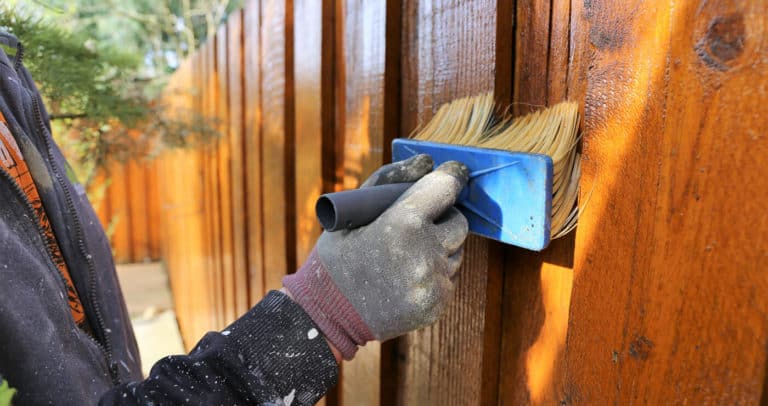STEP BY STEP: How To Stain Your Fence
So you want to know how to stain a fence on your own like a pro?
Items You Will Need To Stain Your Fence:
- 2 Pump Up Garden Sprayers ( one for applying cleaners and one for stain )
- 2" Paint Brushes
- 6" Nap Roller 3/8 Nap
- Drop Cloths
- Minneral Spirits
- Dawn Dish Soap 1 Gal
- Clorox Bleach - 3-5 Gal depending on size of fence
- Wood Defender Fence Stain or Suitable Alternative - 1 Gal for every 125 square feet of fence (if using Wood Defender)

Getting Started Staining Your Fence:
If you want know how to stain a fence like a pro, the first thing you will have to do is prepare the wood. Before any exterior wood structure can be stained, it must be clean and free of any dirt, mold, and mildew. If the structure is constructed from new materials, we recommend waiting long enough for the wood to dry out from the milling process before staining, because the ideal internal moisture content for exterior wood is 13 percent or less. For cedar materials, this usually takes two weeks or less during the warmer months of the year. For structures built with pressure-treated materials, drying out could take three to six months, depending on the UV exposure, temperature, and board type. Weathered wood must be cleaned and bleached prior to staining to kill any mildew spores. No matter the type of wood, we always recommend waiting 24-48 hours after rainfall or cleaning to make sure the structure is dry prior to staining. A moisture meter can be purchased from Home Depot or Lowes for $25 – $30.
If your fence is older and has begun to wether it must be properly prepared prior to staining to kill the mold and mildew spores present and most importantly stop the decay process. Any gray in the wood not cleaned prior to staining will be visible after the staining process has been completed so it is imperative that this is done properly. In order to remove mold and oxidation you can use a mixture of 1/2 Clorox Bleach and 1/2 water in a pump sprayer. Spray the fence in an even up and down pattern and the graying, oxidation, mold will be removed. It is best to rinse the fence after bleaching to neutralize the bleach. Once complete, allow the wood to dry for 24-48 hours until the moisture is below 13%. NOTE: DO NOT PRESSURE WASH YOUR FENCE!!!! Pressure washing wood will cause fuzzing, splintering, and can destroy the wood. If you want to rinse the fence with a pressure washer, use a rinse nozzle at extremely low pressure.
How Much Will It Cost To Stain Your Fence Yourself:
The cost to stain your fence yourself will be less than hiring an expert to do it but not usually by a significant amount unless you have already purchased all the tools. For stain and cleaning supplies for 150′ of fence staining both sides ( 1800 sqft ) you will need approximately 15 gallon of stain; 125 gal per square foot. Quality oil based penetrating stains run about $50 a gallon, so plan on about $700 – $800 for stain. Cleaning materials if you have a fence that has turned gray will cost approximately another $40 – $50. Plan on another $80 – $100 for brushes, pump sprayer, and drop cloths. For planning purposes, $.50 – $.55 a square foot is what you can plan on spending to DIY. For 150′ of fence, to clean and stain it should take the average homeowner with the right tools about 6 – 8 hours to complete. If you think this is more than you want to take on, we are always happy to proved a free estimate and all our work is guaranteed.
Selecting The Best Wood Stain And Tools:
You can go to most hardware stores and find fence stain, thought it makes more sense to choose a high quality product that will yield the best results. That is because not all stains are created equally. If you chose the wrong product, there will be a clear difference when the first inclement weather arrives. We recommend only using oil based penetrating stain like Wood Defender. Unfortunately this is only sold to contractors or you can buy it and have it shipped. If you reach out to us, we can also get the stain for you if you like. The next best big box store alternative would be Ready Seal and is usually available at Lowes or Home Depot.
Next you will need tools to apply the wood stain to your fence. You can use a brush or a roller to handle the job, but a sprayer works the best and will save you a bunch of time. For high quality oil based stain like wood defender, a garden pump sprayer or back pack sprayer will do the trick. If you use a sprayer ensure you use both safety glasses and a respirator. This will prevent the product from spraying back in your eyes or accidentally ingesting it.
Prepare The Wood Surface For Stain:
Before staining any exterior wood structure, it’s important to ensure it is clean and free of dirt, mold, and mildew. If the wood is new, it’s recommended to wait for the wood to dry out from the milling process before staining. The ideal moisture content for exterior wood is 13% or less. Cedar materials usually dry out in two weeks or less during warmer months, while pressure-treated materials may take 3-6 months to dry out, depending on UV exposure, temperature, and board type. Weathered wood must be cleaned and bleached before staining to kill mildew spores. Regardless of the type of wood, it’s always best to wait 24-48 hours after rainfall or cleaning to ensure the wood is dry before staining. You can purchase a moisture meter at Home Depot or Lowes for $25-30.
If your fence is older and has begun to weather, it’s important to prepare it properly before staining to kill mold and mildew spores and stop the decay process. Any gray in the wood that is not cleaned before staining will be visible after the staining process is complete, so it’s crucial to do this properly. To remove mold and oxidation, mix 1/2 Clorox Bleach with 1/2 water in a pump sprayer and evenly spray the fence. It’s best to rinse the fence after bleaching to neutralize the bleach. Allow the wood to dry for 24-48 hours until the moisture is below 13%. NOTE: Do not pressure wash your fence! Pressure washing can cause fuzzing, splintering, and can damage the wood. If you want to rinse the fence with a pressure washer, use a rinse nozzle at extremely low pressure.
Applying Fence Stain:
When choosing a fence stain, it’s important to select a high-quality product for the best results. Not all stains are created equal, and choosing the wrong one may result in a clear difference when the first inclement weather arrives. You can use a brush or roller to apply the stain, but a sprayer is the most efficient and will save you time. For high-quality oil-based stains like Wood Defender, a garden pump sprayer or back pack sprayer will work best. If you use a sprayer, be sure to wear safety glasses and a respirator to prevent the product from spraying back in your eyes or being accidentally ingested.
There are many products to choose from. Wood Defender meets all the requirements when it comes to quality and durability. On top of that, it’s pretty much mistake proof so even if someone has never stained before can apply it like a professional. One of the best features of Wood Defender is that while most stains require back-brushing in order to avoid ugly runs or streaks, Wood Defender does not. Wood Defender leaves no laps, runs or streaks, and requires no back-brushing. On top of all that, some products are temperature sensitive while Wood Defender can be applied in full sunlight and in any temperature, even below freezing. It will never peel or flake allowing easy reapplication over time.
Cleaning Up:
Once you have completed your fence staining job, it’s time to clean up. Use mineral spirits to clean brushes, sprayers, and rollers in order to effectively clean up any residual stain. Once the tools are clean and have been allowed to dry they are ready to be reused on your next stain project.
If any stain has gotten on non-porous surfaces like metal guttering, windows or air conditioners, a little dawn dish soap and water will take it right off. If you have dripped any stain on concrete, immediately put dawn dish soap on full strength and allow it to sit for 30-45 minutes agitating it with a brush then rinse off. This should remove 90% of any stain on concrete. Using a pressure washer can improve results, but be careful as pressure washers can etch concrete.
If you are staining over concrete, pre-wetting it and applying a generous film of 1/2 dawn and 1/2 water pre-mixed applied from a pump sprayer will prevent the stain from soaking into the concrete and can be easily rinsed off when complete.

